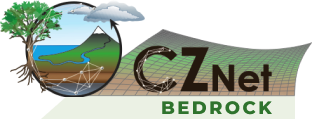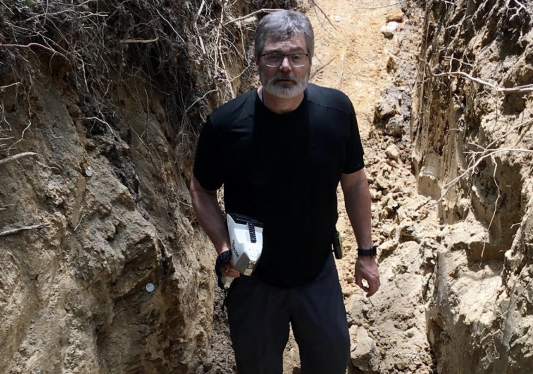"Life is what happens while you are busy making other plans." --- John Lennon
My journey to the critical zone was anything but direct. It began deep in the continental crust, then moved offshore, detoured through seafloor sediments, diverted into oceanography, and finally landed in forested mountain uplands. About every ten years or so, my scientific direction changed dramatically, taking what I call “left turns” that have led me through topics as diverse as crustal seismology, marine geophysics, seismic oceanography, and, finally, critical zone science. It’s a strange enough path that I’m occasionally asked by friends and colleagues why (or more often how) I took those left turns. The “why” is best left for another time, but the “how” turns out to be a lot of luck and serendipity. Allow me to explain.
The constant through my journey has been imaging -- using geophysics to make pictures of structures inside the Earth (or oceans). Imaging amazes me; I’ll never forget the first time, as a junior in college, I saw a seismic reflection profile. I was awestruck that such a clear picture of the subsurface, with details of sedimentary layers and structures like faults, could be created just by sending sound waves down into the Earth. That sense of wonder at geophysical imaging has never left me, and to this day I still often think “I can’t believe this works!” when looking at a new image on the computer screen. I chased that feeling into grad school in the 1980’s and joined one of the groups creating images of mysterious structures near the base of the continental crust (the “Moho”). It was an exciting time; as one of my grad school friends put it, “the Moho is where it’s at.” And for a decade or so, it was! But over time, both funding and progress withered, slowed both by fading novelty and by an inability to definitively test important hypotheses (it’s impossible to drill into the lower continental crust). This taught me a valuable lesson -- don’t plan on working in the same area for your whole career -- and pushed me toward my first big change.
That first “left turn” took me from the continents to the oceans. Via a postdoctoral scholarship and later a research scientist position at Woods Hole Oceanographic Institution, I learned to be a seagoing scientist, sailing on research ships to image the Earth beneath the oceans. I learned to be a marine geophysicist at WHOI, but most of my seagoing years were spent at -- of all places -- the landlocked University of Wyoming, where I took a professorship in the late 1990’s. Over the course of 20+ years, my students, postdocs, and I explored the structure of continental margins, volcanic arcs, and seafloor sediments, sailing on about a dozen different research vessels, from seismic ships like the Ewing and Marcus Langseth, to the drill ship JOIDES Resolution. I even spent a day in the submersible Alvin, voyaging to the bottom of the sea at nearly 3,000 m depth. Going to sea to conduct funded research is a huge privilege, and I loved it. I’ve seen the northern lights between Greenland and Iceland, ridden out a storm in the Aleutians, circumnavigated the South Island of New Zealand, and dodged icebergs off the Grand Banks of Newfoundland (“I can see how those guys on the Titanic got in trouble,” said the captain of the Ewing one foggy evening in Iceberg Alley). “I could do this forever,” I thought. (Spoiler alert: I didn’t.)
The next big “left turn” in my career started completely by accident, while I was at sea aboard the Ewing in the Newfoundland Basin off eastern Canada. Watching the computer monitors in the main lab one day, I saw something impossible: reflections - echoes from our ship’s sound sources - coming back from inside the ocean. That couldn’t be -- the ocean is just water, so there isn’t anything inside it to reflect sound waves, right? Sitting in the lab, I went through a mental checklist of all the other things that might explain the observation: a misfiring sound source (nope, not happening), a seafloor multiple (nope, wrong shape), a submarine (nope, too deep), a whale (nope, too persistent)... until eventually I concluded, per Sherlock Holmes, “when you have eliminated all which is impossible, then whatever remains, however improbable, must be the truth.” I was seeing, for the first time, reflections from tiny temperature changes inside the ocean -- what physical oceanographers call “fine-structure.” That story could fill another whole blog post, but long story short, I spent the next ten years developing what is now called “seismic oceanography,” the use of reflection seismology to image inside the ocean. Many scientists have now adopted this technique to create beautiful images of dynamic ocean features, including fronts, eddies, lee waves, internal waves, and turbulence. Seismic oceanography was a really exciting discovery, and great fun to work on, and I thought I would spend the rest of my career doing it. (Spoiler alert: I didn’t.)
The final left turn, the one that pulled me into the critical zone, came through three serendipitous interactions at the University of Wyoming. The first was befriending Cliff Riebe, a CZ scientist par excellence with whom, happily, I still collaborate. Cliff and I would occasionally talk science over lunch in the Ross Hall dining room (a location selected more for its convenient location than for the quality of the cuisine). Cliff’s descriptions of his work in the critical zone taught me two things: first, that there were fascinating, world-class scientific questions to be addressed there (who knew?), and second, that seismic imaging could help tackle those questions. (My words to Cliff were something like, “dude, you need seismics.”) I was now officially CZ-curious.
My curiosity deepened through the second serendipitous event, when our department’s summer field camp coordinator invited the geophysics faculty to create a weeklong summer field camp module. For the next several summers, using mostly borrowed equipment, I taught summer field students near-surface geophysics pretty much while learning it myself. And many of the students loved it, feeling some of that same excitement at imaging the ground beneath their feet that I had experienced decades earlier. Critical zone geophysics, it turns out, has a magical ability to get undergraduates excited about geophysics. (Inexplicably, my classroom lectures on reflection seismology failed to have the same effect.)
By this point I was convinced that moving into critical zone geophysics was a left turn worth taking -- there was great science to be done; hypotheses could be formulated and tested without waiting years for a research vessel; and it was a fantastic way to get students excited about geophysics. Only one problem remained: I had no funding for CZ geophysics.
The solution to this problem -- and the third moment of serendipity -- came in the form of a generic listserv email from UW’s Research Office, announcing a pre-proposal competition for a special National Science Foundation program. I nearly deleted the email -- I distinctly recall my finger hovering over the delete key -- but for some reason I decided to read it first. Long story short, that email contained the opportunity that led to a $20 million NSF grant, which created the Wyoming Center for Environmental Hydrology and Geophysics (WyCEHG). (Moral of the story: think twice before deleting listserv emails that include funding opportunities.) That grant changed my life: we built a fabulous near-surface geophysics facility, hired Brad Carr to run it, and embarked on a five-year mission to explore strange new worlds… well, to advance geophysical characterization of the critical zone (which was strange and new to me). Our team worked at sites across the continental U.S., from South Carolina to northern California, including at six different Critical Zone Observatory sites. The collaborations fostered during the WyCEHG days led directly to the Critical Zone Collaboration Network team that I’m part of now.
So, the path was circuitous, but I’m glad it led me to the critical zone. Why? Because CZ science is interdisciplinary and collaborative. I’ve worked with geochemists, hydrologists, soil scientists, geomorphologists, and plant physiologists -- and our progress depends on everyone. Because CZ science is complex, yet testable. So much is happening in the CZ (Mycorrhizal fungi! Water partitioning! Geochemical weathering!) -- yet ground truth is always just a shallow drillhole away. And our students can formulate a hypothesis on Monday and test it in the field on Saturday. And because CZ science matters. As CZ scientists like to point out, the critical zone provides vital “ecosystem services” -- clean water, fertile soil, healthy forests, and crucial habitats. Our society needs to understand how those systems work, and how they might be affected by disturbances like climate change. It’s a privilege to be part of a program -- NSF’s Critical Zone Collaboration Network -- that’s working on the answers. In fact, I think I’ve taken my last left turn. Probably.

